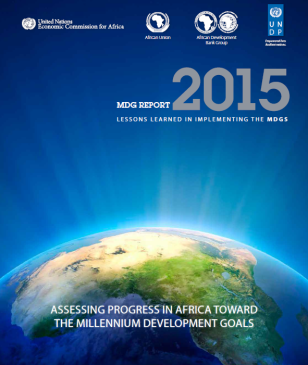Africa MDGs Report 2015 - Lessons Learned

Africa MDGs Report 2015 - Lessons Learned
October 7, 2015
Africa has made considerable progress towards achieving the Millennium Development Goals despite challenging initial conditions. The baseline figures for Africa on most Millennium Development Goal indicators were relatively low compared to other regions. Nevertheless the continent has achieved impressive
gains, including in placing more children in primary school, bridging the gender gap in primary enrolment, increasing the representation of women in national parliaments, reducing child and maternal deaths and reducing the prevalence
of HIV/AIDS. These achievements underscore the important role that national commitment, supported by global partnership, can play in realizing development objectives. The highlights of Africa’s performance on the MDGs are discussed below.
Highlights
- Africa excluding North Africa reduced poverty levels from 56.5 per cent in 1990 to 48.4 per cent in 2010, a 14 per cent reduction, well below the MDG target of 28.25 per cent.
- Africa’s GDP growth has remained positive since 2001, averaging at least 5 per cent above the global average of 3 per cent.
- Africa excluding North Africa remains the most food-deficient of all regions of the world, with 25 per cent of its population having faced hunger and malnutrition during the 2011-2013 period, a modest 8 per cent improvement from the level experienced during the 1990-1992 period.
- With a 67 per cent primary completion rate, Africa is still far from the achieving primary education completion rates for all by 2015. Barely 20 per cent of African countries reached the target in 2012.
- The youth literacy rate for the population aged 15-24 years has improved in Africa as a result of the increased access to universal primary education observed since 2000.
- In terms of reaching parity at all levels of education, Southern Africa has continued to register a strong performance, followed by North Africa, which has reached parity in all levels except for primary education and has made exceptional progress in tertiary education.
- Overall, African countries have made substantial progress towards achieving MDG 4 (Reduce child mortality). Indeed, 99 of 188 countries, including 43 in Africa, excluding North Africa, observed more significant decreases in child mortality during the 2000-2013 period than during the 1990- 2000 period.
- Africa is leading the way in women’s representation in national parliaments.
- Africa still remains the region with the highest maternal mortality ratio compared to the rest of the world, registering 289 maternal deaths per 100,000 live births compared to the global average of 210 maternal deaths per 100,000 live births in 2013.
- Efforts to combat HIV/AIDS, malaria and tuberculosis in Africa have yielded impressive results since 1990 and are placing the continent on a solid path to reversing the spread of these diseases.
- Almost a quarter of the current African population (24 per cent) have gained access to an improved drinking water source since 2000, which is the lowest globally.
- Africa’s progress on environmental targets exceeds global performance.
- The proportion of people with access to improved sanitation has increased only moderately in Africa excluding North Africa, from 24 per cent in 1990 to 30 per cent in 2012.
- Total foreign debt has been higher than 30 per cent of GDP in Africa since 2010 and is expected to rise to 37.1 per cent of GDP in 2015. Net foreign debt as a share of GDP is projected to be only 1 per cent of GDP in 2015.
- Fixed telephone subscriptions per 100 inhabitants peaked in 2009, averaging 4.17 from 1.44 in 1990. Thereafter, it has steadily declined to 3.60 in 2013. This is closely related to fast growth of populations and mobile telephone subscriptions.

 Locations
Locations